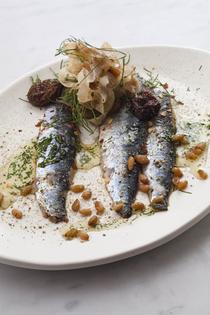The ultimate winter antipasti: sardines in saor
Before there was such a thing as refrigeration, "in saor" (or the technique of marinating fried food in vinegar) was a favorite method of conservation for Venetian fishermen. And while fish are the most popular ingredient in saor, the Venetian countryside was known for using this method with chicken or vegetables such as eggplant. Sardines in saor, recipe from "Molto Gusto" (Ecco 2010), is my ultimate winter antipasti with the sweetness of raisins, the sourness of champagne vinegar and the nutty creaminess of toasted pine nuts all balanced into one plate of taste bud perfection.
Pine nuts are the seeds from the pinecones of a stone pine, Pinus pinea. The best are the longer oval-shaped ones from the Mediterranean; try to get these rather than the more triangular-shaped variety from Asia. Because of their high oil content, pine nuts can turn rancid quickly. Store them in the freezer, and always taste one before adding the nuts to a dish.
There are now dozens of brands of salt in the market. At OTTO, we use Maldon sea salt in most dishes. Harvested along England's Atlantic coast, Maldon sea salt is a high-quality flaky sea salt with a delicate, briny taste. Look for it in gourmet markets and some supermarkets.
I also like sea salt, both fine and coarse, from Sicily. I use the coarse salt, with its large, chunky grains for finishing meat and fish, as well as for sprinkling on focaccia and other flatbreads.
When serving wine with this dish, you want a bottle that can counterbalance the intense flavor of sardines. My friend and wine expert, Dan Amatuzzi, of Eataly NYC, suggested a pairing right away when I was grocery shopping to make this dish. He selected a Verdicchio from the Le Marche region of Italy, with sweet pear notes, to drink with my classic Venetian dish of quickly fried fish marinated in champagne vinegar.
SARDINES IN SAOR
Serves 6
1 medium fennel bulb
1 pound fresh sardines
Maldon or other flaky sea salt
1/2 cup champagne vinegar
2 tablespoons sugar
1 bay leaf, preferably fresh
1 teaspoon ground cinnamon
1/4 cup raisins
1/4 cup pine nuts, toasted (see note)
Cut the stalks off the fennel bulb and reserve the fronds for garnish. Halve the fennel bulb lengthwise. Using a Benriner (Japanese mandoline) or other vegetable slicer, shave the fennel into paper-thin slices; or use a large sharp knife to slice it as thin as possible.
To prepare the sardines, scrape off any scales with a blunt knife; cut off the fins. Cut off the head and tail of each fish and slit it open down the stomach. Pull out the backbone and the guts (a messy job but quite easy). Open out the fish and cut the two fillets apart. Rinse the sardines well under cold water to remove any blood, and pat dry.
Lay the fillets skin side up in a baking dish that holds them in a single layer. Sprinkle with salt, and scatter the shaved fennel over them.
Combine the vinegar, sugar, bay leaf, cinnamon and raisins in a small saucepan. Bring to a boil, stirring to dissolve the sugar, and boil for 3 minutes. Pour the vinegar mixture evenly over the sardines. Let cool before serving. (The sardines can be refrigerated for up to three days; serve cold, or bring to room temperature before serving.)
Just before serving, scatter the toasted pine nuts and reserved fennel fronds over the sardines.
Recipe note: To toast pine nuts, spread them on a baking sheet and toast in a 350 F oven, stirring occasionally, until fragrant and golden brown, 8 to 10 minutes. Pine nuts can burn easily so check on them frequently. Transfer to a plate to cool.
(Mario Batali is the award-winning chef behind twenty-five restaurants including Eataly, Del Posto, and his flagship Greenwich Village enoteca, Babbo.)







